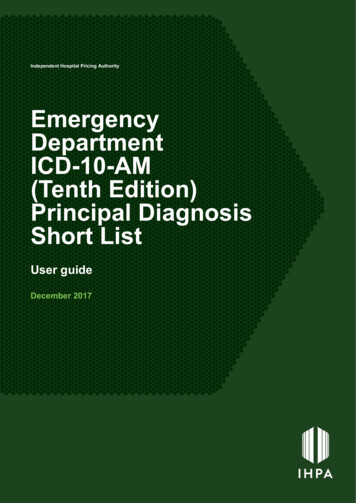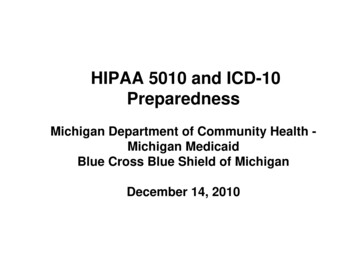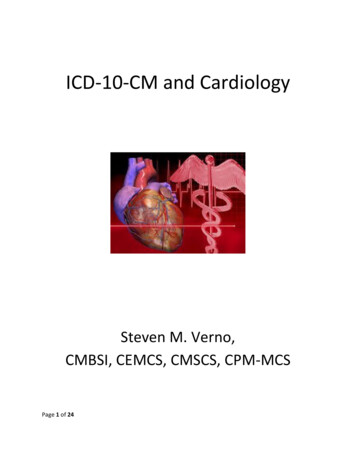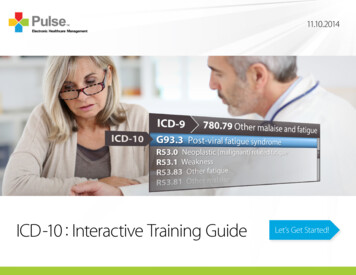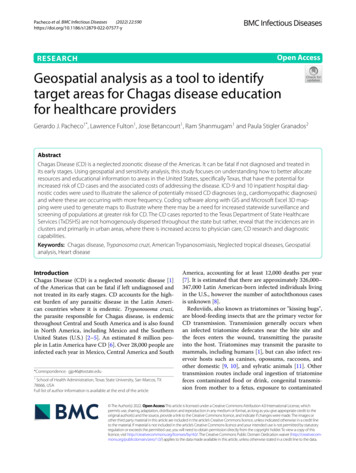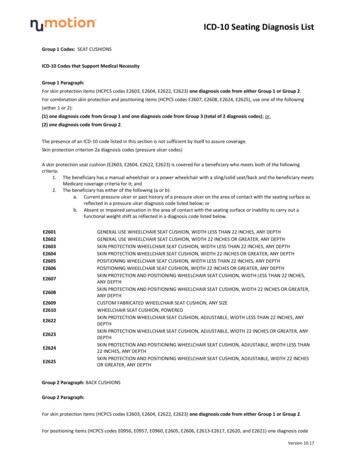
Transcription
ICD-10 Seating Diagnosis ListGroup 1 Codes: SEAT CUSHIONSICD-10 Codes that Support Medical NecessityGroup 1 Paragraph:For skin protection items (HCPCS codes E2603, E2604, E2622, E2623) one diagnosis code from either Group 1 or Group 2.For combination skin protection and positioning items (HCPCS codes E2607, E2608, E2624, E2625), use one of the following(either 1 or 2):(1) one diagnosis code from Group 1 and one diagnosis code from Group 3 (total of 2 diagnosis codes); or,(2) one diagnosis code from Group 2.The presence of an ICD-10 code listed in this section is not sufficient by itself to assure coverage.Skin protection criterion 2a diagnosis codes (pressure ulcer codes)A skin protection seat cushion (E2603, E2604, E2622, E2623) is covered for a beneficiary who meets both of the followingcriteria:1. The beneficiary has a manual wheelchair or a power wheelchair with a sling/solid seat/back and the beneficiary meetsMedicare coverage criteria for it; and2. The beneficiary has either of the following (a or b):a. Current pressure ulcer or past history of a pressure ulcer on the area of contact with the seating surface asreflected in a pressure ulcer diagnosis code listed below; orb. Absent or impaired sensation in the area of contact with the seating surface or inability to carry out afunctional weight shift as reflected in a diagnosis code listed 9E2610E2622E2623E2624E2625GENERAL USE WHEELCHAIR SEAT CUSHION, WIDTH LESS THAN 22 INCHES, ANY DEPTHGENERAL USE WHEELCHAIR SEAT CUSHION, WIDTH 22 INCHES OR GREATER, ANY DEPTHSKIN PROTECTION WHEELCHAIR SEAT CUSHION, WIDTH LESS THAN 22 INCHES, ANY DEPTHSKIN PROTECTION WHEELCHAIR SEAT CUSHION, WIDTH 22 INCHES OR GREATER, ANY DEPTHPOSITIONING WHEELCHAIR SEAT CUSHION, WIDTH LESS THAN 22 INCHES, ANY DEPTHPOSITIONING WHEELCHAIR SEAT CUSHION, WIDTH 22 INCHES OR GREATER, ANY DEPTHSKIN PROTECTION AND POSITIONING WHEELCHAIR SEAT CUSHION, WIDTH LESS THAN 22 INCHES,ANY DEPTHSKIN PROTECTION AND POSITIONING WHEELCHAIR SEAT CUSHION, WIDTH 22 INCHES OR GREATER,ANY DEPTHCUSTOM FABRICATED WHEELCHAIR SEAT CUSHION, ANY SIZEWHEELCHAIR SEAT CUSHION, POWEREDSKIN PROTECTION WHEELCHAIR SEAT CUSHION, ADJUSTABLE, WIDTH LESS THAN 22 INCHES, ANYDEPTHSKIN PROTECTION WHEELCHAIR SEAT CUSHION, ADJUSTABLE, WIDTH 22 INCHES OR GREATER, ANYDEPTHSKIN PROTECTION AND POSITIONING WHEELCHAIR SEAT CUSHION, ADJUSTABLE, WIDTH LESS THAN22 INCHES, ANY DEPTHSKIN PROTECTION AND POSITIONING WHEELCHAIR SEAT CUSHION, ADJUSTABLE, WIDTH 22 INCHESOR GREATER, ANY DEPTHGroup 2 Paragraph: BACK CUSHIONSGroup 2 Paragraph:For skin protection items (HCPCS codes E2603, E2604, E2622, E2623) one diagnosis code from either Group 1 or Group 2.For positioning items (HCPCS codes E0956, E0957, E0960, E2605, E2606, E2613-E2617, E2620, and E2621) one diagnosis codeVersion 10.17
ICD-10 Seating Diagnosis Listfrom either Group 2 or Group 3.For combination skin protection and positioning items (HCPCS codes E2607, E2608, E2624, E2625), use one of the following(either 1 or 2):(1) one diagnosis code from Group 1 and one diagnosis code from Group 3 (total of 2 diagnosis codes); or,(2) one diagnosis code from Group 2.The presence of an ICD-10 code listed in this section is not sufficient by itself to assure coverage.Skin Protection criterion 2b diagnosis codes and Positioning criterion 2a diagnosis codesA positioning seat cushion (E2605, E2606), positioning back cushion (E2613-E2616, E2620, E2621), andpositioning accessory (E0955-E0957, E0960) are covered for a beneficiary who meets both of the following:1. The beneficiary has a manual wheelchair or a power wheelchair with a sling/solid seat/back and the beneficiary meetsMedicare coverage criteria for it; and2. The beneficiary has any significant postural asymmetries that are due to one of the following diagnoses:Group 2 1GENERAL USE WHEELCHAIR BACK CUSHION, WIDTH LESS THAN 22 INCHES, ANY HEIGHT, INCLUDINGANY TYPE MOUNTING HARDWAREGENERAL USE WHEELCHAIR BACK CUSHION, WIDTH 22 INCHES OR GREATER, ANY HEIGHT,INCLUDING ANY TYPE MOUNTING HARDWAREPOSITIONING WHEELCHAIR BACK CUSHION, POSTERIOR, WIDTH LESS THAN 22 INCHES, ANY HEIGHT,INCLUDING ANY TYPE MOUNTING HARDWAREPOSITIONING WHEELCHAIR BACK CUSHION, POSTERIOR, WIDTH 22 INCHES OR GREATER, ANYHEIGHT, INCLUDING ANY TYPE MOUNTING HARDWAREPOSITIONING WHEELCHAIR BACK CUSHION, POSTERIOR-LATERAL, WIDTH LESS THAN 22 INCHES, ANYHEIGHT, INCLUDING ANY TYPE MOUNTING HARDWAREPOSITIONING WHEELCHAIR BACK CUSHION, POSTERIOR-LATERAL, WIDTH 22 INCHES OR GREATER,ANY HEIGHT, INCLUDING ANY TYPE MOUNTING HARDWARECUSTOM FABRICATED WHEELCHAIR BACK CUSHION, ANY SIZE, INCLUDING ANY TYPE MOUNTINGHARDWAREPOSITIONING WHEELCHAIR BACK CUSHION, PLANAR BACK WITH LATERAL SUPPORTS, WIDTH LESSTHAN 22 INCHES, ANY HEIGHT, INCLUDING ANY TYPE MOUNTING HARDWAREPOSITIONING WHEELCHAIR BACK CUSHION, PLANAR BACK WITH LATERAL SUPPORTS, WIDTH 22INCHES OR GREATER, ANY HEIGHT, INCLUDING ANY TYPE MOUNTING HARDWAREGroup 3 Paragraph: POSITIONING ACCESSORIESGroup 3 Paragraph:For positioning items (HCPCS codes E0956, E0957, E0960, E2605, E2606, E2613-E2617, E2620, and E2621) one diagnosis codefrom either Group 2 or Group 3.For combination skin protection and positioning items (HCPCS codes E2607, E2608, E2624, E2625), use one of the following(either 1 or 2):(1) one diagnosis code from Group 1 and one diagnosis code from Group 3 (total of 2 diagnosis codes); or,(2) one diagnosis code from Group 2.Version 10.17
ICD-10 Seating Diagnosis ListA custom fabricated back cushion (E2617) is covered if criteria (2) and (3) are met:1.2.3.Beneficiary meets all of the criteria for a prefabricated skin protection seat cushion OR positioning seat cushion(E2609);Beneficiary meets all of the criteria for a prefabricated positioning back cushion (E2617);There is a comprehensive written evaluation by a licensed/certified medical professional, such as a physical therapist(PT) or occupational therapist (OT), which clearly explains why a prefabricated seating system is not sufficient tomeet the beneficiary’s seating and positioning needs. The PT or OT may have no financial relationship with thesupplier (E2609 & E2617).The presence of an ICD-10 code listed in this section is not sufficient by itself to assure coverage.Positioning Criterion 2b diagnosis codes.Group 3 Codes:WHEELCHAIR ACCESSORY, HEADREST, CUSHIONED, ANY TYPE, INCLUDING FIXED MOUNTINGHARDWARE, EACHWHEELCHAIR ACCESSORY, LATERAL TRUNK OR HIP SUPPORT, ANY TYPE, INCLUDING FIXEDMOUNTING HARDWARE, EACHWHEELCHAIR ACCESSORY, MEDIAL THIGH SUPPORT, ANY TYPE, INCLUDING FIXED MOUNTINGHARDWARE, EACHWHEELCHAIR ACCESSORY, SHOULDER HARNESS/STRAPS OR CHEST STRAP, INCLUDING ANY TYPEMOUNTING HARDWAREMANUAL WHEELCHAIR ACCESSORY, HEADREST EXTENSION, EACHWHEELCHAIR ACCESSORY, MANUAL SWINGAWAY, RETRACTABLE OR REMOVABLE MOUNTINGHARDWARE FOR JOYSTICK, OTHER CONTROL INTERFACE OR POSITIONING ACCESSORYE0955E0956E0957E0960E0966E1028Group 4 Paragraph: MISCELLANEOUSGroup 4 Paragraph:The presence of an ICD-10 code listed in this section is not sufficient by itself to assure coverage. Refer to the section onCoverage Indications, Limitations and/or Medical Necessity for other coverage criteria and payment information.For HCPCS code E2609 custom fabricated seat cushions:A custom fabricated seat cushion (E2609) is covered if criteria (1) and (3) are met.4.5.6.Beneficiary meets all of the criteria for a prefabricated skin protection seat cushion OR positioning seat cushion(E2609);Beneficiary meets all of the criteria for a prefabricated positioning back cushion (E2617);There is a comprehensive written evaluation by a licensed/certified medical professional, such as a physical therapist(PT) or occupational therapist (OT), which clearly explains why a prefabricated seating system is not sufficient toVersion 10.17
ICD-10 Seating Diagnosis Listmeet the beneficiary’s seating and positioning needs. The PT or OT may have no financial relationship with thesupplier (E2609 & E2617).Group 4 8K0669MISCELLANEOUS DME SUPPLY, ACCESSORY, AND/OR SERVICE COMPONENT OF ANOTHER HCPCSCODEMANUAL WHEELCHAIR ACCESSORY, SOLID SEAT INSERTMANUAL WHEELCHAIR ACCESSORY, SOLID SEAT SUPPORT BASE (REPLACES SLING SEAT), INCLUDESANY TYPE MOUNTING HARDWAREBACK, PLANAR, FOR PEDIATRIC SIZE WHEELCHAIR INCLUDING FIXED ATTACHING HARDWARESEAT, PLANAR, FOR PEDIATRIC SIZE WHEELCHAIR INCLUDING FIXED ATTACHING HARDWAREBACK, CONTOURED, FOR PEDIATRIC SIZE WHEELCHAIR INCLUDING FIXED ATTACHING HARDWARESEAT, CONTOURED, FOR PEDIATRIC SIZE WHEELCHAIR INCLUDING FIXED ATTACHING HARDWAREREPLACEMENT COVER FOR WHEELCHAIR SEAT CUSHION OR BACK CUSHION, EACHWHEELCHAIR COMPONENT OR ACCESSORY, NOT OTHERWISE SPECIFIEDWHEELCHAIR ACCESSORY, WHEELCHAIR SEAT OR BACK CUSHION, DOES NOT MEET SPECIFIC CODECRITERIA OR NO WRITTEN CODING VERIFICATION FROM DME PDACVersion 10.17
ICD-10 Seating Diagnosis ListGroup 1ICD-10 essure ulcer of right lower back, unstageablePressure ulcer of right lower back, stage 1Pressure ulcer of right lower back, stage 2Pressure ulcer of right lower back, stage 3Pressure ulcer of right lower back, stage 4Pressure ulcer of left lower back, unstageablePressure ulcer of left lower back, stage 1Pressure ulcer of left lower back, stage 2Pressure ulcer of left lower back, stage 3Pressure ulcer of left lower back, stage 4Pressure ulcer of sacral region, unstageablePressure ulcer of sacral region, stage 1Pressure ulcer of sacral region, stage 2Pressure ulcer of sacral region, stage 3Pressure ulcer of sacral region, stage 4Pressure ulcer of unspecified hip, unstageablePressure ulcer of unspecified hip, stage 1Pressure ulcer of unspecified hip, stage 2Pressure ulcer of unspecified hip, stage 3Pressure ulcer of unspecified hip, stage 4Pressure ulcer of right hip, unstageablePressure ulcer of right hip, stage 1Pressure ulcer of right hip, stage 2Pressure ulcer of right hip, stage 3Pressure ulcer of right hip, stage 4Pressure ulcer of left hip, unstageablePressure ulcer of left hip, stage 1Pressure ulcer of left hip, stage 2Pressure ulcer of left hip, stage 3Pressure ulcer of left hip, stage 4Pressure ulcer of unspecified buttock, unstageablePressure ulcer of unspecified buttock, stage 1Pressure ulcer of unspecified buttock, stage 2Pressure ulcer of unspecified buttock, stage 3Pressure ulcer of unspecified buttock, stage 4Pressure ulcer of right buttock, unstageablePressure ulcer of right buttock, stage 1Pressure ulcer of right buttock, stage 2Pressure ulcer of right buttock, stage 3Pressure ulcer of right buttock, stage 4Pressure ulcer of left buttock, unstageablePressure ulcer of left buttock, stage 1Pressure ulcer of left buttock, stage 2Pressure ulcer of left buttock, stage 3Pressure ulcer of left buttock, stage 4Pressure ulcer of contiguous site of back, buttock and hip, stage 1Pressure ulcer of contiguous site of back, buttock and hip, stage 2Pressure ulcer of contiguous site of back, buttock and hip, stage 3L89.44Pressure ulcer of contiguous site of back, buttock and hip, stage 4L89.45Pressure ulcer of contiguous site of back, buttock and hip, unstageableVersion 10.17
ICD-10 Seating Diagnosis ListGroup .0G36.1G36.8G36.9Sequelae of poliomyelitisGM2 gangliosidosis, unspecifiedSandhoff diseaseTay-Sachs diseaseOther GM2 gangliosidosisUnspecified gangliosidosisMucolipidosis IVOther gangliosidosisKrabbe diseaseMetachromatic leukodystrophyOther sphingolipidosisNeuronal ceroid lipofuscinosisRett's syndromeTropical spastic paraplegiaOther myelitisHuntington's diseaseCongenital nonprogressive ataxiaEarly-onset cerebellar ataxiaLate-onset cerebellar ataxiaCerebellar ataxia with defective DNA repairHereditary spastic paraplegiaOther hereditary ataxiasHereditary ataxia, unspecifiedInfantile spinal muscular atrophy, type I [Werdnig-Hoffman]Other inherited spinal muscular atrophyMotor neuron disease, unspecifiedAmyotrophic lateral sclerosisPrimary lateral sclerosisFamilial motor neuron diseaseProgressive spinal muscle atrophyOther motor neuron diseaseOther spinal muscular atrophies and related syndromesSpinal muscular atrophy, unspecifiedPostpolio syndromeParkinson's diseaseVascular parkinsonismGenetic torsion dystoniaAlzheimer's disease with early onsetAlzheimer's disease with late onsetOther Alzheimer's diseaseAlzheimer's disease, unspecifiedAlpers diseaseLeigh's diseaseSubacute combined degeneration of spinal cord in diseases classified elsewhereCerebellar ataxia in diseases classified elsewhereOther specified degenerative disorders of nervous system in diseases classified elsewhereMultiple sclerosisNeuromyelitis optica [Devic]Acute and subacute hemorrhagic leukoencephalitis [Hurst]Other specified acute disseminated demyelinationAcute disseminated demyelination, unspecifiedVersion 10.17
ICD-10 Seating Diagnosis 11G95.19G99.2I69.051I69.052I69.053I69.054Diffuse sclerosis of central nervous systemCentral demyelination of corpus callosumCentral pontine myelinolysisAcute transverse myelitis in demyelinating disease of central nervous systemSubacute necrotizing myelitis of central nervous systemConcentric sclerosis [Balo] of central nervous systemOther specified demyelinating diseases of central nervous systemDemyelinating disease of central nervous system, unspecifiedMuscular dystrophyCongenital myopathiesSpastic quadriplegic cerebral palsySpastic diplegic cerebral palsySpastic hemiplegic cerebral palsyAthetoid cerebral palsyAtaxic cerebral palsyOther cerebral palsyCerebral palsy, unspecifiedFlaccid hemiplegia affecting unspecified sideFlaccid hemiplegia affecting right dominant sideFlaccid hemiplegia affecting left dominant sideFlaccid hemiplegia affecting right nondominant sideFlaccid hemiplegia affecting left nondominant sideSpastic hemiplegia affecting unspecified sideSpastic hemiplegia affecting right dominant sideSpastic hemiplegia affecting left dominant sideSpastic hemiplegia affecting right nondominant sideSpastic hemiplegia affecting left nondominant sideHemiplegia, unspecified affecting unspecified sideHemiplegia, unspecified affecting right dominant sideHemiplegia, unspecified affecting left dominant sideHemiplegia, unspecified affecting right nondominant sideHemiplegia, unspecified affecting left nondominant sideParaplegia, unspecifiedParaplegia, completeParaplegia, incompleteQuadriplegia, unspecifiedQuadriplegia, C1-C4 completeQuadriplegia, C1-C4 incompleteQuadriplegia, C5-C7 completeQuadriplegia, C5-C7 incompleteOther specified disorders of brainDisorder of brain, unspecifiedOther disorders of brain in diseases classified elsewhereSyringomyelia and syringobulbiaAcute infarction of spinal cord (embolic) (nonembolic)Other vascular myelopathiesMyelopathy in diseases classified elsewhereHemiplegia and hemiparesis following nontraumatic subarachnoid hemorrhage affecting rightdominant sideHemiplegia and hemiparesis following nontraumatic subarachnoid hemorrhage affecting leftdominant sideHemiplegia and hemiparesis following nontraumatic subarachnoid hemorrhage affecting rightnon-dominant sideHemiplegia and hemiparesis following nontraumatic subarachnoid hemorrhage affecting leftnon-dominant sideVersion 10.17
ICD-10 Seating Diagnosis .00Q07.01Q07.02Hemiplegia and hemiparesis following nontraumatic subarachnoid hemorrhage affecting unspecifiedsideHemiplegia and hemiparesis following nontraumatic intracerebral hemorrhage affecting rightdominant sideHemiplegia and hemiparesis following nontraumatic intracerebral hemorrhage affecting left dominantsideHemiplegia and hemiparesis following nontraumatic intracerebral hemorrhage affecting rightnon-dominant sideHemiplegia and hemiparesis following nontraumatic intracerebral hemorrhage affecting leftnon-dominant sideHemiplegia and hemiparesis following nontraumatic intracerebral hemorrhage affecting unspecifiedsideHemiplegia and hemiparesis following other nontraumatic intracranial hemorrhage affecting rightdominant sideHemiplegia and hemiparesis following other nontraumatic intracranial hemorrhage affecting leftdominant sideHemiplegia and hemiparesis following other nontraumatic intracranial hemorrhage affecting right nondominant sideHemiplegia and hemiparesis following other nontraumatic intracranial hemorrhage affecting left nondominant sideHemiplegia and hemiparesis following other nontraumatic intracranial hemorrhage affectingunspecified sideHemiplegia and hemiparesis following cerebral infarction affecting right dominant sideHemiplegia and hemiparesis following cerebral infarction affecting left dominant sideHemiplegia and hemiparesis following cerebral infarction affecting right non-dominant sideHemiplegia and hemiparesis following cerebral infarction affecting left non-dominant sideHemiplegia and hemiparesis following cerebral infarction affecting unspecified sideHemiplegia and hemiparesis following other cerebrovascular disease affecting right dominant sideHemiplegia and hemiparesis following other cerebrovascular disease affecting left dominant sideHemiplegia and hemiparesis following other cerebrovascular disease affecting rightnon-dominant sideHemiplegia and hemiparesis following other cerebrovascular disease affecting leftnon-dominant sideHemiplegia and hemiparesis following other cerebrovascular disease affecting unspecified sideHemiplegia and hemiparesis following unspecified cerebrovascular disease affecting right dominantsideHemiplegia and hemiparesis following unspecified cerebrovascular disease affecting left dominant sideHemiplegia and hemiparesis following unspecified cerebrovascular disease affecting right nondominant sideHemiplegia and hemiparesis following unspecified cerebrovascular disease affecting left non-dominantsideHemiplegia and hemiparesis following unspecified cerebrovascular disease affecting unspecified sideImmobility syndrome (paraplegic)Other specified disorders of muscleCervical spina bifida with hydrocephalusThoracic spina bifida with hydrocephalusLumbar spina bifida with hydrocephalusSacral spina bifida with hydrocephalusUnspecified spina bifida with hydrocephalusCervical spina bifida without hydrocephalusThoracic spina bifida without hydrocephalusLumbar spina bifida without hydrocephalusSacral spina bifida without hydrocephalusSpina bifida, unspecifiedArnold-Chiari syndrome without spina bifida or hydrocephalusArnold-Chiari syndrome with spina bifidaArnold-Chiari syndrome with hydrocephalusVersion 10.17
ICD-10 Seating Diagnosis ListQ07.03Q67.8Q68.1Q74.3Q78.0Arnold-Chiari syndrome with spina bifida and hydrocephalusOther congenital deformities of chestCongenital deformity of finger(s) and handArthrogryposis multiplex congenitaOsteogenesis imperfectaGroup 19DS78.019SMonoplegia of lower limb affecting unspecified sideMonoplegia of lower limb affecting right dominant sideMonoplegia of lower limb affecting left dominant sideMonoplegia of lower limb affecting right nondominant sideMonoplegia of lower limb affecting left nondominant sideMonoplegia of lower limb following nontraumatic subarachnoid hemorrhage affecting right dominant sideMonoplegia of lower limb following nontraumatic subarachnoid hemorrhage affecting left dominant sideMonoplegia of lower limb following nontraumatic subarachnoid hemorrhage affecting right non-dominant sideMonoplegia of lower limb following nontraumatic subarachnoid hemorrhage affecting left non-dominant sideMonoplegia of lower limb following nontraumatic subarachnoid hemorrhage affecting unspecified sideMonoplegia of lower limb following nontraumatic intracerebral hemorrhage affecting right dominant sideMonoplegia of lower limb following nontraumatic intracerebral hemorrhage affecting left dominant sideMonoplegia of lower limb following nontraumatic intracerebral hemorrhage affecting right non-dominant sideMonoplegia of lower limb following nontraumatic intracerebral hemorrhage affecting left non-dominant sideMonoplegia of lower limb following nontraumatic intracerebral hemorrhage affecting unspecified sideMonoplegia of lower limb following other nontraumatic intracranial hemorrhage affecting right dominant sideMonoplegia of lower limb following other nontraumatic intracranial hemorrhage affecting left dominant sideMonoplegia of lower limb following other nontraumatic intracranial hemorrhage affecting rightnon-dominant sideMonoplegia of lower limb following other nontraumatic intracranial hemorrhage affecting leftnon-dominant sideMonoplegia of lower limb following other nontraumatic intracranial hemorrhage affecting unspecified sideMonoplegia of lower limb following cerebral infarction affecting right dominant sideMonoplegia of lower limb following cerebral infarction affecting right non-dominant sideMonoplegia of lower limb following cerebral infarction affecting left non-dominant sideMonoplegia of lower limb following cerebral infarction affecting unspecified sideMonoplegia of lower limb following other cerebrovascular disease affecting right dominant sideMonoplegia of lower limb following other cerebrovascular disease affecting left dominant sideMonoplegia of lower limb following other cerebrovascular disease affecting right non-dominant sideMonoplegia of lower limb following other cerebrovascular disease affecting left non-dominant sideMonoplegia of lower limb following other cerebrovascular disease affecting unspecified sideMonoplegia of lower limb following unspecified cerebrovascular disease affecting right dominant sideMonoplegia of lower limb following unspecified cerebrovascular disease affecting left dominant sideMonoplegia of lower limb following unspecified cerebrovascular disease affecting right non-dominant sideMonoplegia of lower limb following unspecified cerebrovascular disease affecting left non-dominant sideMonoplegia of lower limb following unspecified cerebrovascular disease affecting unspecified sideOsteogenesis imperfectaComplete traumatic amputation at right hip joint, initial encounterComplete traumatic amputation at right hip joint, subsequent encounterComplete traumatic amputation at right hip joint, sequelaComplete traumatic amputation at left hip joint, initial encounterComplete traumatic amputation at left hip joint, subsequent encounterComplete traumatic amputation at left hip joint, sequelaComplete traumatic amputation at unspecified hip joint, initial encounterComplete traumatic amputation at unspecified hip joint, subsequent encounterComplete traumatic amputation at unspecified hip joint, sequelaVersion 10.17
ICD-10 Seating Diagnosis l traumatic amputation at right hip joint, initial encounterPartial traumatic amputation at right hip joint, subsequent encounterPartial traumatic amputation at right hip joint, sequelaPartial traumatic amputation at left hip joint, initial encounterPartial traumatic amputation at left hip joint, subsequent encounterPartial traumatic amputation at left hip joint, sequelaPartial traumatic amputation at unspecified hip joint, initial encounterPartial traumatic amputation at unspecified hip joint, subsequent encounterPartial traumatic amputation at unspecified hip joint, sequelaComplete traumatic amputation at level between right hip and knee, initial encounterComplete traumatic amputation at level between right hip and knee, subsequent encounterComplete traumatic amputation at level between right hip and knee, sequelaComplete traumatic amputation at level between left hip and knee, initial encounterComplete traumatic amputation at level between left hip and knee, subsequent encounterComplete traumatic amputation at level between left hip and knee, sequelaComplete traumatic amputation at level between unspecified hip and knee, initial encounterComplete traumatic amputation at level between unspecified hip and knee, subsequent encounterComplete traumatic amputation at level between unspecified hip and knee, sequelaPartial traumatic amputation at level between right hip and knee, initial encounterPartial traumatic amputation at level between right hip and knee, subsequent encounterPartial traumatic amputation at level between right hip and knee, sequelaPartial traumatic amputation at level between left hip and knee, initial encounterPartial traumatic amputation at level between left hip and knee, subsequent encounterPartial traumatic amputation at level between left hip and knee, sequelaPartial traumatic amputation at level between unspecified hip and knee, initial encounterPartial traumatic amputation at level between unspecified hip and knee, subsequent encounterPartial traumatic amputation at level between unspecified hip and knee, sequelaComplete traumatic amputation of right hip and thigh, level unspecified, initial encounterComplete traumatic amputation of right hip and thigh, level unspecified, subsequent encounterComplete traumatic amputation of right hip and thigh, level unspecified, sequelaComplete traumatic amputation of left hip and thigh, level unspecified, initial encounterComplete traumatic amputation of left hip and thigh, level unspecified, subsequent encounterComplete traumatic amputation of left hip and thigh, level unspecified, sequelaComplete traumatic amputation of unspecified hip and thigh, level unspecified, initial encounterComplete traumatic amputation of unspecified hip and thigh, level unspecified, subsequent encounterComplete traumatic amputation of unspecified hip and thigh, level unspecified, sequelaPartial traumatic amputation of right hip and thigh, level unspecified, initial encounterPartial traumatic amputation of right hip and thigh, level unspecified, subsequent encounterPartial traumatic amputation of right hip and thigh, level unspecified, sequelaPartial traumatic amputation of left hip and thigh, level unspecified, initial encounterPartial traumatic amputation of left hip and thigh, level unspecified, subsequent encounterPartial traumatic amputation of left hip and thigh, level unspecified, sequelaPartial traumatic amputation of unspecified hip and thigh, level unspecified, initial encounterPartial traumatic amputation of unspecified hip and thigh, level unspecified, subsequent encounterPartial traumatic amputation of unspecified hip and thigh, level unspecified, sequelaComplete traumatic amputation at knee level, right lower leg, initial encounterComplete traumatic amputation at knee level, right lower leg, subsequent encounterComplete traumatic amputation at knee level, right lower leg, sequelaComplete traumatic amputation at knee level, left lower leg, initial encounterComplete traumatic amputation at knee level, left lower leg, subsequent encounterComplete traumatic amputation at knee level, left lower leg, sequelaComplete traumatic amputation at knee level, unspecified lower leg, initial encounterComplete traumatic amputation at knee level, unspecified lower leg, subsequent encounterComplete traumatic amputation at knee level, unspecified lower leg, sequelaPartial traumatic amputation at knee level, right lower leg, initial encounterVersion 10.17
ICD-10 Seating Diagnosis .619Z89.621Z89.622Z89.629Partial traumatic amputation at knee level, right lower leg, subsequent encounterPartial traumatic amputation at knee level, right lower leg, sequelaPartial traumatic amputation at knee level, left lower leg, initial encounterPartial traumatic amputation at knee level, left lower leg, subsequent encounterPartial traumatic amputation at knee level, left lower leg, sequelaPartial traumatic amputation at knee level, unspecified lower leg, initial encounterPartial traumatic amputation at knee level, unspecified lower leg, subsequent encounterPartial traumatic amputation at knee level, unspecified lower leg, sequelaComplete traumatic amputation of right lower leg, level unspecified, initial encounterComplete traumatic amputation of right lower leg, level unspecified, subsequent encounterComplete traumatic amputation of right
ICD-10 Seating Diagnosis List Version 10.17 Group 2 B91 Sequelae of poliomyelitis E75.00 GM2 gangliosidosis, unspecified E75.01 Sandhoff disease E75.02 Tay-Sachs disease E75.09 Other GM2 gangliosidosis E75.10 Unspecified gangliosidosis E75.11 Mucolipidosis IV E75.19 Other gangliosidosis E75.23 Krabbe disease E75.25 Metachromatic leukodystrophy
